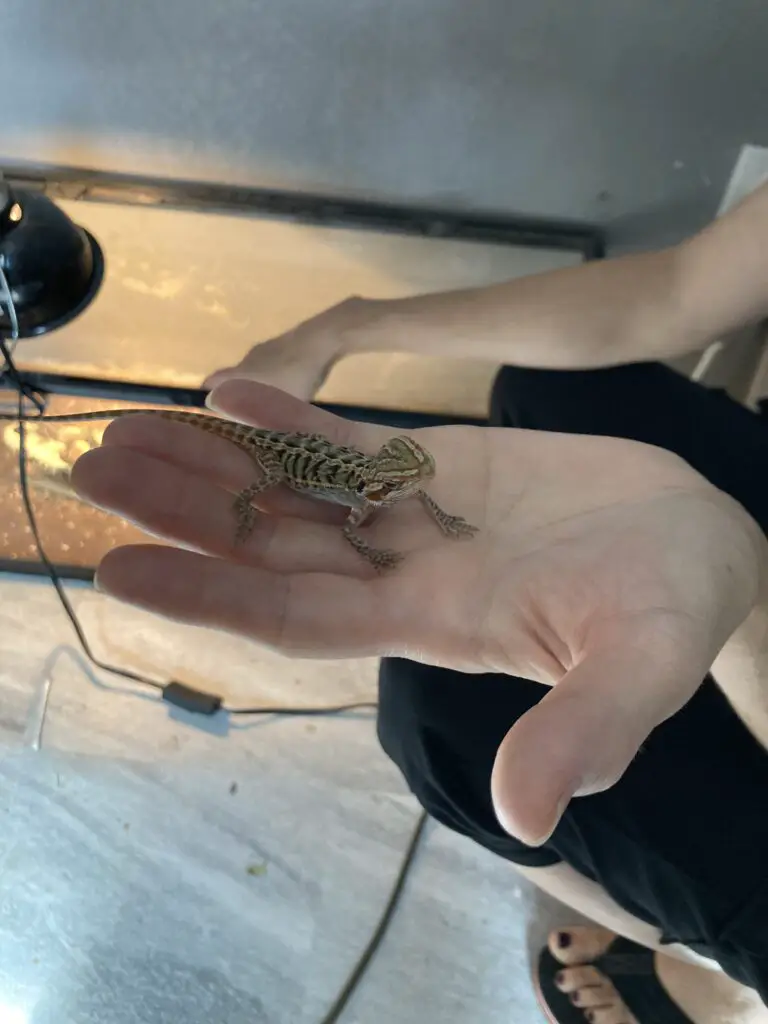This page may contain affiliate links that allow us to make a small commission from qualifying purchases (at no extra cost to yourself). We appreciate your support.
Bearded Dragons have a reputation for being some of the most incredible and sociable pet lizards to have in the reptile family, but it is quite common for pet owners to have concerns regarding the issue of biting.
Bearded Dragons do bite. They have a set of teeth and a jaw capable of biting just as much as it is good at gripping and grinding food. A bite from a bearded dragon will feel like a small sharp pinch and is almost always no cause for concern. Nevertheless, biting is unusual for Bearded Dragons, and the behavior could be caused by various factors.
Now that we know Bearded dragons are capable of biting let’s dive deeply into why they bite, what this behavior could indicate, and look at some practical steps on how to best avoid being bitten.
Why do Bearded Dragons Bite?
It should be noted that it is rare for Adult Bearded Dragons to bite their handlers. This behavior is more likely to be seen in hatchlings and Baby Beardies (ages 0 to 4 months) who are new and adapting to the stresses of being in the outward environment.
Juveniles such as these are generally 3 – 4 inches long and may perceive the human as a threat, causing them to defend themselves reflexively. The biting behavior may also come about due to feelings of hunger, poor handling, or general curiosity.

At this stage, it is advised to keep handling to a minimum to avoid causing serious injury to the dragon as it is prone to trauma from falling on hard surfaces or being crushed under a weight. With regular feeding and time spent within its enclosure, your dragon will get used to the environment and grow to trust you.
When an Adult Bearded Dragon begins to bite, some reasons you should consider for this behavior include:
- Hunger
- Provocation
- Poor Handling
- Stress
- Physical Illness
- Overcrowding
- Territorial behavior
Are Bearded Dragons Aggressive?
Beardies are generally docile and sociable towards humans. They do not exhibit aggressive behavior unless in the event of such conditions as listed above.
If your dragon exhibits aggressive behavior, which includes scratching, biting, hissing, or whipping you with its tail, it’s their way of telling you either something is wrong or they feel threatened in their environment. This is never done with the intention of hurting the handler.
Does a Bearded Dragon Bite Hurt?
Potentially from well matured dragons but a Beardies bite is usually harmless to humans. The dragon’s age and the extent of force used are factors worth considering when discussing the degree of pain experienced after a dragon’s bite.
So bear with me. I’m about to get a little technical but the below information is useful for understanding how your dragon is evolving and growing and how that can affect their bite. Let’s do it!
Bearded Dragons possess acrodont teeth in the upper portion of their oral cavity. What this means is the upper teeth do not possess true roots or sockets—they are fixed directly into the gums. The lower teeth are pleurodont, meaning they are attached to the sides of the jawbone and not on the jawbone as is in humans.

Younger dragons have smaller, more fine, and needle-like teeth for gripping prey. They also have fewer teeth than adults, about 60-80 in total. For this reason, a bite from a younger dragon will barely, if at all, break the skin barrier.
More mature dragons have flat-topped and widened teeth for grinding, which can cause injury, predisposing the area to zoonosis (a disease which can be transmitted to humans from animals) like Salmonella, which is a common intestinal bacteria in reptiles, and tetanus. The area may feel tender, itchy, red, and swollen for a couple of days after a bite, with the possibility of slight bleeding.
In the event of such, it is important to open the mouth of the dragon gently in order to release its grip and avoid further injury. If there is no breech in the bite area, wash it out with soap and hot water. If there is a breech, disinfect the area with alcohol and put a band-aid over it after washing.
Clean and monitor bite wounds over the course of a few days. If symptoms persist, please seek expert medical care.
How to Prevent a Dragon’s Bite
Here are some ways you can keep safe and prevent being bitten by your pet dragon.
Ensure They Are Being Fed Appropriately
Feeding should be done at intervals of 2-3 times a day. They are to be fed on animal, insect, and vegetable matter and have water available to keep them hydrated. Nutrient-rich commercialized feeds are available for ease of the process.
My Beardies are a huge fan of Fluker’s Medley Treat from Amazon. Its affordable and provides a variety of insects they absolutely love!
Younger beardies should be fed on small vegetable pellets or the young of insects such as cricket pinheads and larvae, as the digestive tracts of young beardies are still developing, and eating more mature ones may risk intestinal blockage.
My favorite for baby beardies is Fluker’s Veggie Variety Pellets on Amazon. It’s a good blend that provides enough calories for your young beardies to grow big and strong.
Ensure their feeding bowls are thoroughly washed free of cleaning chemicals, as that may predispose them to illness. The temperature, humidity, and lighting in their environment should also be optimized for their comfort.
Learn Proper Handling
Hands must be washed thoroughly with soap and water before and after handling to avoid contamination and bacterial transfer to the dragon.
Here’s a table to guide you in handling your dragon.
| For Baby Beardies & Juveniles | For Adult Beardies |
| Avoid approaching them suddenly. | Approach by first supporting the body |
| Approach gently and slowly with non-threatening gestures. Avoid direct eye contact. Use a soft, calm voice. | Do not grab it by the tail, neck, or legs. Offer it your hand instead. |
| Position your finger under the dragon’s chin and guide it towards the body. Wait for it to grab on. | Gradually allow it to perch on your chest or shoulder, keeping a supporting hand available. |
| Always support with both palms of your hand, and hold with their head facing away from you. | Hold it in your hand and support its tail with your upper arm. |
| Do not squeeze, press, or provoke your baby dragon. Always hold at a low height to avoid injury. | Do not hold at a great height as they may fall and incur injuries. |
As a general rule, avoid over-handling as that puts stress on the small animal both in the juvenile and adult stages.
Avoid Crowding Your Bearded Dragons Tank
Bearded Dragons are solitary in nature and take on aggressive territorial behavior when they feel threatened or perceive a potential threat in their immediate environment.
Male dragons are particularly known for their displays of dominance, including head-bobbing, hissing, beard puffing, and a change of beard color to black when they feel their dominance is threatened in their established home. They are likely to attack a non-submissive occupant, even if it’s a female in this scenario.
Handling should be completely avoided during such displays. If two dragons are engaged in a fight in a shared enclosure, it is best to separate them into different enclosures or move them to a larger, more spacious environment with a divider in place to prevent them from seeing each other.
Evaluate the physical damages done due to the fight and ensure each dragon receives adequate space and resources to prevent future fighting. When ready, you can then reintroduce them and monitor them closely.
Final Thoughts
Bearded Dragons are fantastic pets, but understanding and addressing their biting tendencies is key to a harmonious relationship. Bites are typically mild, but age, stress, and territorial behavior can play a role.
By following the practical advice provided, like proper handling, feeding, and tank management, owners can reduce the risk of bites and create a comfortable environment for their Bearded Dragons. With patience and care, owning these reptiles can be a rewarding experience.

Meet Brad, the creator behind Vivarium Vibes, where his deep connection with nature and animals truly comes to life.
